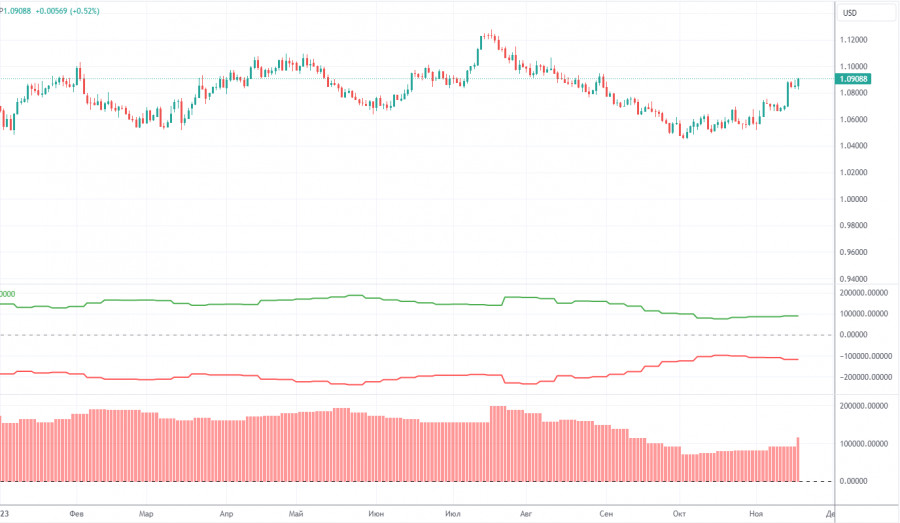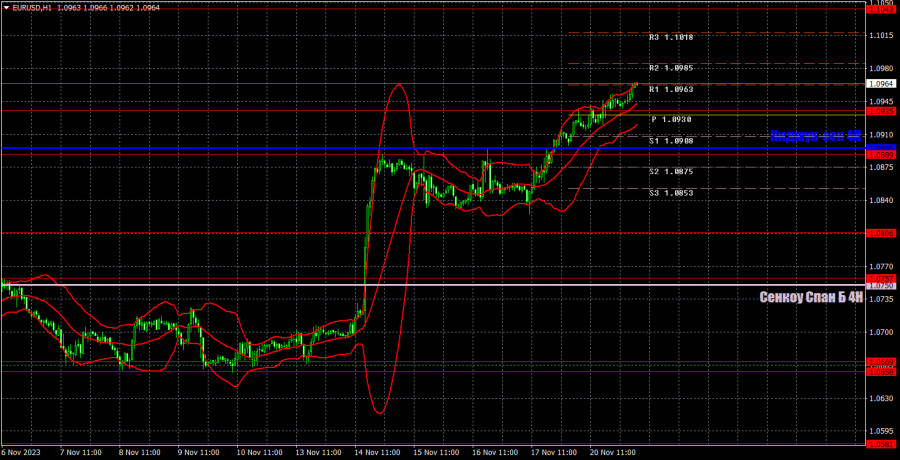

EUR/USD traded higher on Monday. The US dollar continued to fall for the third consecutive day for no apparent reason. Yesterday, there were no important or even mildly interesting events that could have triggered such movement. Nevertheless, EUR/USD continues to show an upward movement, although it would be logical for the pair to fall instead. However, the market seems to have entered a stage similar to the first half of 2023. At that time, the single currency either grew or stood still, although several factors predicted its fall. Therefore, it would be inappropriate to talk about how logical the movements have been.
Four trading signals were generated yesterday, and all of them left much to be desired, as volatility was just 54 pips. Obviously, with such volatility and trends, the pair constantly retraces during the day and, accordingly, repeatedly hits the same levels, forming signals that do not work properly. Yesterday, two sell signals were generated around the level of 1.0935, after that there were two buy signals. However, the pair repeatedly failed to move 15 pips in the intended direction, which would have been enough to set a stop loss to breakeven. Even the trading signals show how illogical the movements have been.
COT report:
On Friday, a new COT report for November 7 was released. Over the past 12 months, the COT report data has been consistent with what's happening in the market. The net position of large traders (the second indicator) began to rise back in September 2022, roughly at the same time that the euro started to rise. In the first half of 2023, the net position hardly increased, but the euro remained relatively high during this period. Only in the last three months, we have seen a decline in the euro and a drop in the net position, as we anticipated. Currently, the net position of non-commercial traders is still bullish and this trend is likely to lose momentum soon.
We have previously noted that the red and green lines have moved significantly apart from each other, which often precedes the end of a trend. This configuration persisted for over half a year, but ultimately, the lines have started moving closer to each other. Therefore, we still stick to the scenario that the upward trend is over. During the last reporting week, the number of long positions for the "non-commercial" group increased by 1,700, while the number of short positions fell by 2,000. Consequently, the net position increased by 3,700. The number of BUY contracts is still higher than the number of SELL contracts among non-commercial traders by 89,000. In principle, it is now evident even without COT reports that the euro is set to extend its weakness. However, the corrective phase has not yet ended.
Analysis of EUR/USD 1H
On the 1-hour chart, the pair exhibited another corrective phase. Two out of the five phases in the current correction were triggered by weak U.S. reports, and it is quite difficult to find grounds for the current upward movement. Therefore, for now, we can say that the U.S. reports have been boosting the euro. Nonetheless, it seems like the market is ready to buy for no reason. We need to wait for the pair to breach the Senkou Span B and Kijun-sen lines in order to identify the recommencement of the downtrend in the medium-term.
On November 21, we highlight the following levels for trading: 1.0530, 1.0581, 1.0658-1.0669, 1.0757, 1.0806, 1,0889, 1,0935, 1,1012, 1,1092, 1,1137, as well as the Senkou Span B line (1.0750) and Kijun-sen (1.0895). The Ichimoku indicator lines can shift during the day, so this should be taken into account when identifying trading signals. There are also auxiliary support and resistance levels, but signals are not formed near them. Signals can be "bounces" and "breakouts" of extreme levels and lines. Don't forget to set a breakeven Stop Loss if the price has moved in the right direction by 15 pips. This will protect against potential losses if the signal turns out to be false.
On Tuesday, there is no significant event planned in the European Union and the United States. In our opinion, the FOMC minutes will not have a significant impact on the pair. We could assume that we are facing a flat or a correction, but it appears that the market is ready to buy for no particular reason.
Description of the chart:Support and resistance levels are thick red lines near which the trend may end. They do not provide trading signals;
The Kijun-sen and Senkou Span B lines are the lines of the Ichimoku indicator, plotted to the 1H timeframe from the 4H one. They provide trading signals;
Extreme levels are thin red lines from which the price bounced earlier. They provide trading signals;
Yellow lines are trend lines, trend channels, and any other technical patterns;
Indicator 1 on the COT charts is the net position size for each category of traders;
Indicator 2 on the COT charts is the net position size for the Non-commercial group.